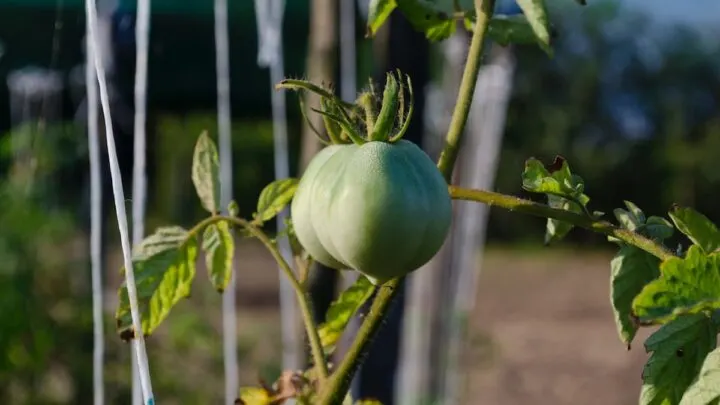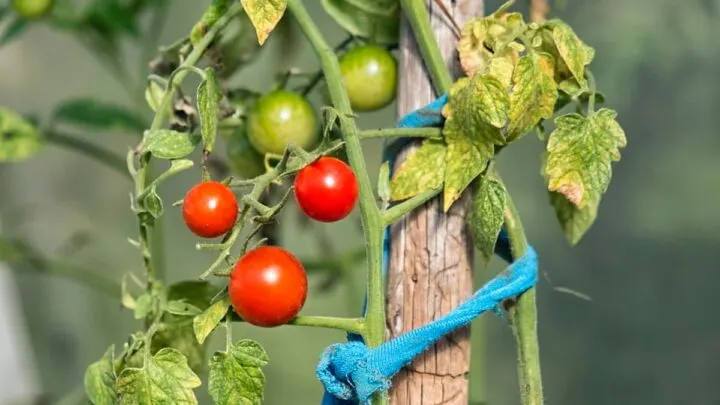Tomatoes are some of the most common vegetables you’ll find in home gardens, and there are many reasons they’re a popular plant for home horticulture.
For one thing, tomatoes can produce many fruits per vegetable plant, are relatively easy to preserve and store long term, and are used in various cuisines. They’re a flexible vegetable to grow at home and are even a good starter vegetable for new gardeners.
But the problem with growing tomatoes is that they can be relatively picky about some things, especially temperature. Growing your tomato plant in the wrong temperatures can stunt the plant, reduce fruiting, and make them less productive even once temperatures are ideal.
So what temperature kills tomato plants, and are deadly temperatures the only thing you should worry about?
Tomato plants die outright when they get below 32 degrees Fahrenheit or 0 degrees Celcius. However, they can start to show signs of stress and don’t do as well in temperatures as high as 50 degrees Fahrenheit. Ideal temperatures for a tomato plant are between about 55-75 degrees Fahrenheit.
But do you need to keep tomatoes at their ideal temperature for a good harvest? What if you have a late frost or an unseasonable snowstorm?
Bad weather is becoming a more significant challenge for home gardeners everywhere. So we’ll also spend some time discussing how to protect your tomato plants and what you can do to help your tomatoes thrive even when outdoor conditions aren’t ideal.

What Is The Lowest Temperature A Tomato Plant Can Survive?
The lowest temperature your tomatoes can survive is freezing, 32 degrees Fahrenheit or 0 degrees Celcius. However, there are a few exceptions to this.
If the outdoor temperature dips below freezing for a couple of minutes, that won’t necessarily kill your tomato plants, assuming that there is still some heat being stored in the plant itself and the soil around their roots.
That might seem like an arbitrary distinction to make, but it’s essential. A soft freeze that doesn’t dip below freezing for very long won’t necessarily kill tomatoes – though it will almost always damage them. But a long freeze, lasting more than an hour or so, will kill pretty much any tomatoes exposed to it.
That means that one of the ways you can avoid your tomatoes dying in unseasonably cold weather, or if you accidentally plant them too early, is by protecting your tomato plants from the cold.
Covering your tomatoes or surrounding them with warm straw or other protective measures can help keep the temperature low enough to kill your tomatoes.
What’s important here is the temperature of the tomato plant rather than the temperature around the tomato plant. Anything that keeps the tomato plant itself above freezing will help it survive.
That said, tomatoes aren’t going to thrive in cold weather like that. Even if you manage to keep the plants above freezing, you’ll still see some problems, and some parts of tomatoes may get too cold even if most of the plant is okay.

How Do You Keep Your Tomato Plants Warm Overnight?
There are a few ways to keep your tomatoes warm overnight, depending on where you’ve planted them and how cold it’s likely to get.
For instance, tomatoes can be planted in a greenhouse much earlier than they can be planted outside. That’s because the greenhouse helps store thermal energy, keeping it warmer overnight and even warming the ground inside the greenhouse.
Even a portable or temporary greenhouse setup will help hold more heat overnight for your tomatoes.
Tarps are another good option if your plants risk getting too cold overnight. Even draping a tarp over your tomato plant’s cages (not the plants themselves!) can help hold in some heat. Tarps are also a good option in the snow because snow is a wonderful insulator!
Another option for growing your tomato plants in containers is to bring your tomatoes inside.
As a warning for container growers, the containers can reduce how much thermal mass your tomatoes have, and their roots can be more vulnerable to the cold. If you’re growing in containers, we recommend bringing your tomatoes inside anytime the temperature drops below 40 degrees Fahrenheit.
One last alternative, packing straw bales around the plants in your garden is another great way to insulate them, especially if it’s going to get a little too cold for several days in a row.
Plus, any loose straw that falls out of the bales acts like mulch and will biodegrade into wonderful fertilizer!

Should I Cover My Tomato Plants At 39 Degrees Fahrenheit?
Tomatoes will show signs of temperature stress anytime the temperature dips below 50 degrees Fahrenheit, which can slow their development.
So, if you’re looking at temperatures below 39 degrees, offering them a little protection or support is a good idea. Covering the tomatoes isn’t always the best option because it means they aren’t getting as much light, but providing some ground cover or a transparent cover is a good option.
Think carefully about how often and how long the temperature will be at or below 39 degrees to decide how much protection your tomato plants need.
Can Tomato Plants Handle 35-Degree Weather?
Tomato plants won’t die in 35-degree weather, assuming they’re otherwise well taken care of. However, they will stress, may wilt a little bit until temperatures warm back up, and will often have slower growth for a few days or even a week after temperatures get too cold.
How Do You Cover Tomato Plants?
Usually, if you’re covering tomato plants, it’s important to cover the cages around them rather than the tomatoes themselves. That way, you don’t have any extra weight bending your tomato stems.
Additionally, having the cover on the cages instead of on the tomatoes themselves protects them from the cold temperatures being transferred through the cover into the tomato leaves.
If there’s a lot of space between your tomato plants, that are a good thing for covering them because it means you’re holding more warm air near the plants.
If the wind is a concern, you can stake down the tarp or use a wheelbarrow, your gardening tools, or even bales of hay to hold the cover in place.

When Should I Bring My Tomato Plants Inside?
Tomato plants love coming inside when they live in containers! Containers have less thermal mass than the soil, so it’s a good idea to keep your plants a little more mobile until temperatures warm up.
Consider bringing your tomatoes inside any time it drops below 50 degrees, and bring them inside when the temperature goes below 40 degrees.
Neither of those temperatures will kill your tomato plants, but they will slow tomato growth. So, instead of waiting longer for your first harvest, bring your tomatoes inside where they can enjoy the same shelter as you!
As a note, please remember that tomato leaves are toxic and that tomato plants should be kept away from pets and small children that might try to eat them.
When Is Too Early To Plant Tomato Plants?
In general, you don’t want to plant tomato plants until soil temperatures are consistently above freezing, and at or above 40 degrees is ideal.
When your soil reaches that point depends on many factors, like how much direct sunlight your garden gets, average temperatures in your area, how much moisture you’re getting, and the composition of your soil.
Remember, tomatoes prefer a lot of moisture and slightly loamy but still well-drained soil.
If you aren’t sure if the soil is ready, wait another week and see what temperatures are like then.
Can Tomato Plants Get Heat Stress?
Yes! While cold temperatures are more harmful to tomatoes in general, tomatoes get heat stress as well.
Warm days, especially anything above 80 degrees, can heat stress your tomatoes in direct sunlight. Above 90 degrees and tomatoes in the partial sun may also start to heat stress.
The good news is that a sunshade and a little extra water can help tomatoes overcome heat stress.
However, if these temperatures hit during the start of the fruiting season, you might have some delays since tomatoes often hold buds and flowers back when stressed. Wait for things to cool off and offer your tomatoes some extra support; they’ll set fruit when temperatures cool off.

Hi there, my name is Allie and welcome to my blog; GareningWithAllie!
Much of what you see written here is just our personal experiences with gardening. Along with the content I write here, there is also a unique collection of gardening topics covered by some of our close friends. I hope you find everything you read here to be helpful, informative, and something that can make your gardening journey the most lovely experience ever! With that said, Happy Gardening!
